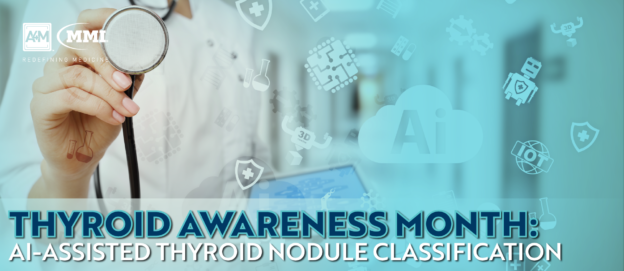January marks the beginning of Thyroid Awareness Month , which aims to spread awareness of thyroid conditions affecting over 20 million individuals living within the United States. Up to 60% of those with thyroid disease are unaware of their condition, while women are significantly more likely to experience thyroid issues than men. Although the underlying causes of thyroid disease are largely unknown, it is important to routinely evaluate the thyroid as undiagnosed thyroid disease can put patients at risk for severe health complications – including cardiovascular disease, osteoporosis, and infertility.
Alongside conditions such as hyperthyroidism and hypothyroidism, the thyroid may also frequently develop nodules. Most don’t cause any symptoms and are benign in the majority of cases, however, a small percentage of thyroid nodules are cancerous. To improve early detection techniques, research efforts have begun investigating the potential benefit of employing artificial intelligence (AI) in classifying thyroid nodules.
The applications of artificial intelligence in medicine continue to expand, recently including the analysis of chest radiographs, detection of abnormal cell growths, as well as histology analysis. As part of the latest efforts to apply artificial intelligence to support the clinical practice, researchers at Mercy Hospital in Springfield, Missouri evaluated the efficacy of an AI algorithm at identifying malignant thyroid nodules.
AI-Assisted Thyroid Nodule Classification
Chair of the Department of Endocrinology at Mercy Hospital, Johnson Thomas, MD, presented the research team’s findings at the 89th American Thyroid Association annual meeting. According to the trial’s results, a novel image similarity algorithm revealed similar accuracy – at times improved – to the best available ultrasound-based classification systems in classifying thyroid nodules.
“By using image similarity AI models we can eliminate subjectivity and decrease the number of unnecessary biopsies,” by as much as 50%, Dr. Thomas told Medscape in an interview.
Increased Accuracy and Decreased Number of Biopsies
Thyroid nodules are extremely prevalent, yet only a small percentage of cases are threatening. Current noninvasive classification systems that do not require patients to undergo unnecessary biopsies are all subjective and leave much to be desired. AI, on the other hand, has been designed to employ deep learning models to decrease subjectivity affecting image interpretation. Similar systems have already been approved by the FDA for other applications, including diabetic retinopathy, stroke, breast lesions, Dr. Thomas noted.
Creating the model required the use of deep learning in which an algorithm processed all available images for 482 nodules from patients who underwent biopsies or thyroid surgery at Mercy Hospital between February 2012 and February 2017. To further evaluate accuracy, the researchers tested 103 thyroid nodules in patients who underwent biopsy or surgery through July 2018. Out of all of the tested nodules, 66 were found to be malignant in the training set and 33 were malignant in the latter test set.
The study found that the AI system had a sensitivity of 87.8% and a specificity of 78.5%, with an overall accuracy of 81.5%. “The results suggest the use of the image similarity AI system could result in a 57.3% reduction in biopsies,” Dr. Thomas concluded.
Benefits of AI Technology
The new algorithm has an advantage of objectivity in thyroid nodule assessment as it doesn’t provide a binary outcome; results are not simply categorized as either malignant or benign but allow for physician input in determining the diagnosis. Dr. Thomas and colleagues’ system was developed using an image similarity algorithm, which provides physicians with visual comparisons for interpretation. AI and Machine imaging learning such as this algorithm can function as assistive types of technology, with the potential to have a great impact on imaging results of not only the thyroid but all other parts of the body.
The New AI System
Dr. Thomas and his colleagues’ system differs from other algorithms in that it utilizes ultrasound images through convolutional layers to generate unique image vectors, which are stored in a larger database. Comparing multiple vectors from a test image allows for risk stratification in classifying nodules and increased subjectivity. Instead of computing a diagnosis of either malignant or benign, the system introduces the objectivity missing from AI-assisted technologies. “Physicians can compare similar images with known diagnoses and make their own decision. I think once physicians start using our system, they will trust this more than a black box algorithm,” Dr. Thomas told Medscape Medical News.
While the novel technology is promising, the system still needs to be validated with data from other medical institutions outside of Mercy Hospital. Not only has it proven capable of improving specificity and subjectivity, but it also holds the potential for risk stratification of nodules at point of care, as it can be used on mobile devices, computers, and even as a cloud service. Researchers hope that the integration of their new algorithm will decrease the number of unnecessary biopsies performed while increasing the accuracy of classification systems for such a prevalent condition.

